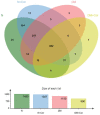The effect of cordycepin on brain oxidative stress and protein expression in streptozotocin-induced diabetic mice
- PMID: 34334512
- PMCID: PMC8498841
- DOI: 10.1292/jvms.21-0268
The effect of cordycepin on brain oxidative stress and protein expression in streptozotocin-induced diabetic mice
Abstract
Diabetes mellitus (DM) is characterized by metabolic disorders and psychological deficits, including cognitive decline. Here, we investigated the effect of cordycepin on oxidative stress and protein expression in the brains of diabetic mice. Twenty-four mice were divided into four groups, one comprising untreated healthy mice (N); one comprising healthy mice treated with cordycepin (24 mg/kg body weight) (N+Cor); one comprising untreated DM mice; and one comprising DM mice treated with cordycepin (24 mg/kg body weight) (DM+Cor). After 14 days of treatment, cognitive behavior was assessed using the novel object recognition (NOR) test. The brain levels of oxidative stress markers (glutathione, catalase, and superoxide dismutase) were examined using the respective detection kits. Protein expression in brain tissues was assessed by liquid chromatography with tandem mass spectrometry (LC-MS/MS); the functions of the identified proteins were annotated by PANTHER, while major protein-protein interactions were assessed using STITCH. We found that cordycepin treatment significantly decreased body weight and food and water intake in the DM+Cor group compared with that in the DM group; however, no differences in blood glucose levels were found between the two groups. Cordycepin treatment significantly reversed cognitive decline in diabetic mice in the NOR test and ameliorated antioxidant defenses. Additionally, we identified ULK1 isoform 2, a protein associated with cognitive function via the activated AMPK and autophagic pathways, as being uniquely expressed in the DM+Cor group. Our findings provide novel insights into the cellular mechanisms underlying how cordycepin improves cognitive decline in diabetic mice.
Keywords: brain protein; cognitive function; cordycepin; diabetes mellitus; free radical.
Conflict of interest statement
The authors declare no conflict of interest in the present study.
Figures





Similar articles
-
Metabolic impacts of cordycepin on hepatic proteomic expression in streptozotocin-induced type 1 diabetic mice.PLoS One. 2021 Aug 13;16(8):e0256140. doi: 10.1371/journal.pone.0256140. eCollection 2021. PLoS One. 2021. PMID: 34388207 Free PMC article.
-
Ameliorative role of Cyanus depressus (M.Bieb.) Soják plant extract against diabetes-associated oxidative-stress-induced liver, kidney, and pancreas damage in rats.J Food Biochem. 2022 Oct;46(10):e14314. doi: 10.1111/jfbc.14314. Epub 2022 Jul 8. J Food Biochem. 2022. PMID: 35802765
-
Expression of α-Klotho Is Downregulated and Associated with Oxidative Stress in the Lens in Streptozotocin-induced Diabetic Rats.Curr Eye Res. 2021 Apr;46(4):482-489. doi: 10.1080/02713683.2020.1805768. Epub 2020 Aug 14. Curr Eye Res. 2021. PMID: 32744464
-
The role of spironolactone on myocardial oxidative stress in rat model of streptozotocin-induced diabetes.Cardiovasc Ther. 2017 Apr;35(2). doi: 10.1111/1755-5922.12242. Cardiovasc Ther. 2017. PMID: 27992114
-
Phytochemical Analysis of Paliurus spina-christi Fruit and Its Effects on Oxidative Stress and Antioxidant Enzymes in Streptozotocin-Induced Diabetic Rats.Appl Biochem Biotechnol. 2020 Aug;191(4):1353-1368. doi: 10.1007/s12010-020-03287-w. Epub 2020 Feb 26. Appl Biochem Biotechnol. 2020. PMID: 32103469
Cited by
-
Cordycepin from Cordyceps militaris ameliorates diabetic nephropathy via the miR-193b-5p/MCL-1 axis.Chin Med. 2023 Oct 13;18(1):134. doi: 10.1186/s13020-023-00842-5. Chin Med. 2023. PMID: 37833817 Free PMC article.
References
-
- Ahn H., Cho H., Cho Y.2020. Anti-oxidant and anti-hyperlipidemic effects of cordycepin-rich Cordyceps militaris in a Sprague-Dawley rat model of alcohol-induced hyperlipidemia and oxidative stress. Bioresour. Bioprocess. 7: 33. doi: 10.1186/s40643-020-00323-9 - DOI
-
- Alberti K. G., Zimmet P. Z.1998. Definition, diagnosis and classification of diabetes mellitus and its complications. Part 1: diagnosis and classification of diabetes mellitus provisional report of a WHO consultation. Diabet. Med. 15: 539–553. doi: 10.1002/(SICI)1096-9136(199807)15:7<539::AID-DIA668>3.0.CO;2-S - DOI - PubMed
-
- Barman S., Pradeep S. R., Srinivasan K.2018. Zinc supplementation alleviates the progression of diabetic nephropathy by inhibiting the overexpression of oxidative-stress-mediated molecular markers in streptozotocin-induced experimental rats. J. Nutr. Biochem. 54: 113–129. doi: 10.1016/j.jnutbio.2017.11.008 - DOI - PubMed
MeSH terms
Substances
LinkOut - more resources
Full Text Sources
Research Materials

